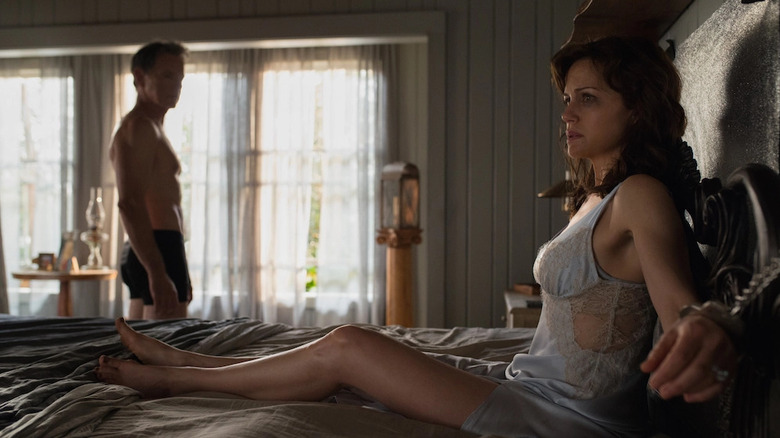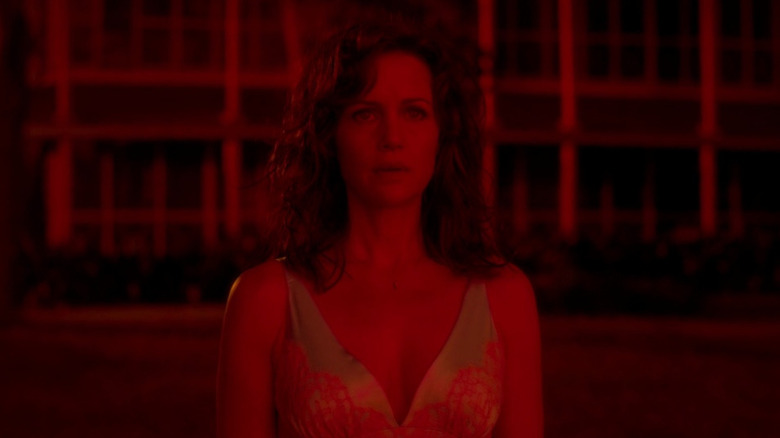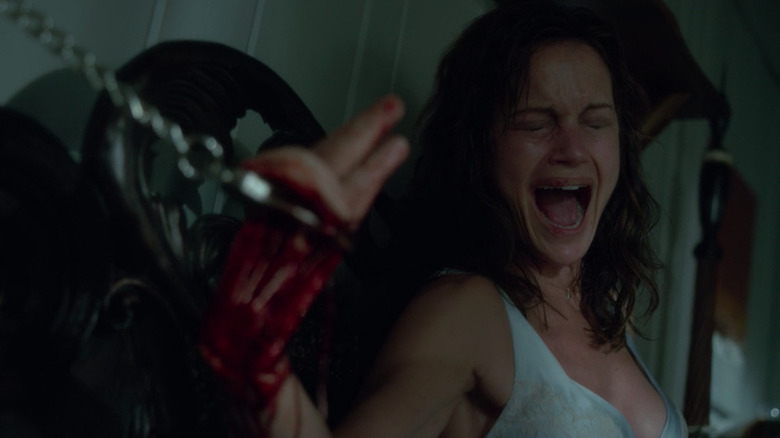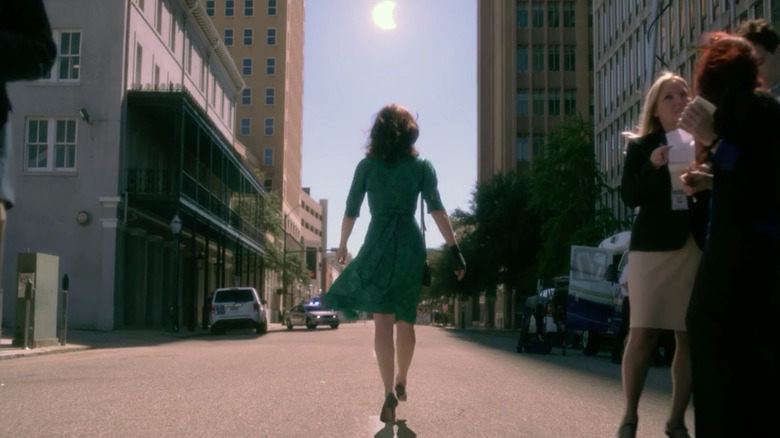The One Gerald's Game Scene That Hit Fans The Hardest
It was important that she see what she was doing, because she felt almost nothing at first; she could have cut her wrist to bleeding ribbons and felt little save those distant sensations of pressure and warmth.
Stephen King is not the man you come to for a gentle bedtime story, and frankly, neither is Mike Flanagan. The former, a prolific author with over 60 novels and 200 short stories to his name, and the latter, an American director born in Salem and obsessed with ghosts real and metaphorical, both like to play in harder genre sandboxes. Finally in 2017, the confluence came when Flanagan got the chance to adapt King's 1992 novel "Gerald's Game" for Netflix. Therein, Jessie (Carla Gugino) and husband Gerald (Bruce Greenwood) engage in some spicy bedroom bondage, which is interrupted by a struggle, Gerald's heart attack, and his death. Chained to the bed in a remote lakeside vacation home with no help coming, Jessie must facilitate her own survival and escape as the night and her mind conspire against her.
Both book and film spend the bulk of their run in this location, focused on this problem. Over an hour and 43 minutes, the subject matter onscreen gets heavy — the ordeal opens up old scars on the bound woman's brain, including a nasty bit of sexual trauma. But the moment that rocketed to the top of the water cooler conversation in the weeks following the movie's arrival was far more visceral: Jessie had to get out of those cuffs, one way or another. The keys sit devastatingly out of cuffed arm's reach, and after various non-invasive failures, Jessie finally reaches a solution not too far removed from the extreme one seen in Danny Boyle's "127 Hours." The result is a parade of viscera and grotesquery that instantly, irrevocably imprints on the mind: the degloving scene.
The book version
"No chickening out," she tells herself.
In King's novel, an entire chapter is spent observing Jessie mentally steeling herself for the deed and struggling with the small shards of glass already embedded in her fingers. The curved blade of busted glass reminds her of "something to be carried by a warlike pixie on its way to do battle with a toadstool," while she tries to convince herself that skinning a limb might be just like carving roast beef. When Chapter 31 arrives, King takes his time as calmly as Laurence Olivier's Nazi dentist asks, "Is it safe?" to a captive Dustin Hoffman in "Marathon Man." King dispenses a thousand tiny cuts to the reader with each mounting account of injury. A special gem occurs in the beginning descriptions, where King points out the exact spot where the cut is made:
Hand tilted back, Jessie sank her inner wrist – that part which bears the lines palm-readers call the Bracelets of Fortune – onto the broken curve of the glass. She watched, fascinated, as the jutting point first dimpled her skin, then popped it. She kept pressing and her wrist kept eating the glass.
As Jessie watches her hand slip slidin' away like the Paul Simon song, King uses universal reference points like the Bracelets of Fortune, prompting the reader to constantly cast repulsed glances at their own right hand and weigh whether or not they'd have the gumption to do the same. It's a mechanism echoed in the hallways of James Wan's "Saw," where the question isn't how badly it'll hurt, but how badly you want to live.
Laying the groundwork from page to screen
King's novel released in 1992, and it would be another 25 years before Mike Flanagan brought the story to the big screen. The biggest hurdle to a faithful adaptation happens to be the book's greatest strength: its internal monologues of a woman losing her grip on reality. Flanagan, a year removed from a hat trick of horror ("Hush," "Before I Wake," and "Ouija: Origin of Evil" would all drop in 2016), successfully translated the intense mental strain to a visual-heavy medium through the creation of manifested proxies — walking, talking projections of Gerald and Jessie herself who echo the trapped woman's inner dread. Jessie's silent chats with herself were illuminating and necessary for the character, but "It needed to be in someone's mouth," the director told /Film. With internal talks becoming external, three-way conversations, Flanagan felt that he "blew it wide open," story-wise.
Spending most of her screen time seated and cuffed, Carla Gugino oscillates between empowered strength and helpless fear, and the viewer can never predict which will drive her character's choices in a fantastic performance, whether or not the cool kids at the Academy acknowledged it. For "Gerald's Game" co-writer and frequent Flanagan collaborator Jeff Howard, it wasn't creatively difficult to make such an amendment to the work of a King. Not only did Sidney Lumet's contained 1982 comedy-thriller "Death Trap" remain in the back of Howard's mind when adapting the single-location novel, but the screenwriter had, along with Flanagan, kept survival due north at all times during the process. He told /Film:
"The entire story is Jessie just talking to herself the entire time. So whether it's represented in the book by all of her friends and neighbors and people she grew up with, or whether it's in this movie with Gerald, she's really just talking to herself. She's exploring the darkest parts of her mind to figure out how to find the answer to survive."
Dubbed "Jessie 2" by various crewmembers during production, the walking version of Jesse Burlingame would be a composite of several hallucinated faces and feelings she encounters in the novel, largely acting as the elephant-sized inconvenient truths sitting in every therapist's office. "You married into the only dynamic you've ever known," she taunts herself, acknowledging the abuser Jessie gravitated towards. It's those hurdles to spiritual peace that prove to be the hardest to overcome, on top of the wild animals, threat of starvation, and potential boogeyman haunting her.
"The principle difference is the sound."
The most notorious scene of "Gerald's Game" is not just a gruesome gimmick; it's a metamorphosis. "We always looked at Jessie 2 as who Jessie needed to turn into by the end of this," said Flanagan, referring to the empowered, walking manifestation of herself that Jessie hallucinates during the waking nightmare. Carla Gugino's performance leans into the temperament of each version of Jessie: the actor would begin her shooting days playing the free-roaming Jessie when she was at her most energetic, saving the cuffed Jessie's lines for later in the day when natural exhaustion could work its way into the performance. But it wasn't Gugino's sleepy eyes that made audiences recoil.
A shard of broken glass acts as a makeshift scalpel while Jessie effectively skins her right hand in order to slip out of the cuff and reach the key that sits atop a nearby bureau. The book's corresponding chapter describes Jessie's procedure with all of the detail King can muster, comparing the woman's skin sloughing off at the handcuff's borders as, "Sliding the way a heavy object on a rug will slide if someone pulls on the rug." It conjures up some rough visuals, and Flanagan was up for the challenge of making the gory moment resemble what readers have imagined in their heads:
"I'll tell you, the principle difference is the sound. I think that's the only difference. When I was reading it for the first time, I had to put the book down. It turned my stomach just reading it. Visually, I don't think we even took it as far as he took it in the book. I think the hand/glove came just about completely off. For us we had it kind of flop back down afterwards because it was just too grizzly. I heard people say, "Oh my God, it's even worse than described." I don't think it actually is. I think the difference is, for all its description, the thing you never consider is the sound. Because we weren't really using music in the film almost ever, all that sound design is just front and center. That's kind of what makes it so intense. Even when I would look away while we were shooting it and when we were editing, you can't get away from the sound. It's some of the most uncomfortable noise and we just crank it right up."
Gnarly.
Catharsis
Her hand no longer looked like the sort of equipment normally issued to human beings, but it was her hand, and it was free.
Free.
Both King's Jessie and Flanagan's iteration of the character make it out of the lake house alive, minus one non-functioning appendage. The blood, sweat, and tears were worth it; in the end, Jessie successfully emerges from the bedroom chrysalis with emergent wings, having confronted parts of herself and the men in her life that inflicted those scars on her psyche. Jeff Howard characterized Jessie's thoughts and movements as motivated "to figure out how to find the answer to survive," a theme that stretches its skinned fingertips throughout Flanagan's oeuvre. From the home invasion horror of "Hush" to the spiritual crises of his "Midnight Mass" series, Flanagan's characters often operate on empty fumes to begin with, functional but unfulfilled. Whether the conflicted siblings of "Oculus," an entire messed-up family in "Hill House," or a traumatized trophy wife in "Gerald's Game," Flanagan's stories and retellings concern themselves with people who don't yet realize that they're drowning. For Jessie Burlingame, the realization came almost too late — but she had too much skin in the game to turn back.




